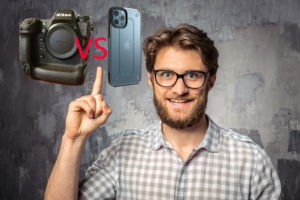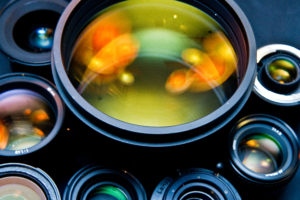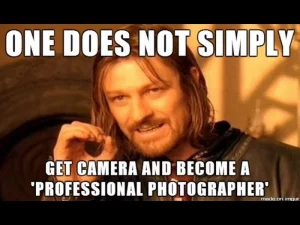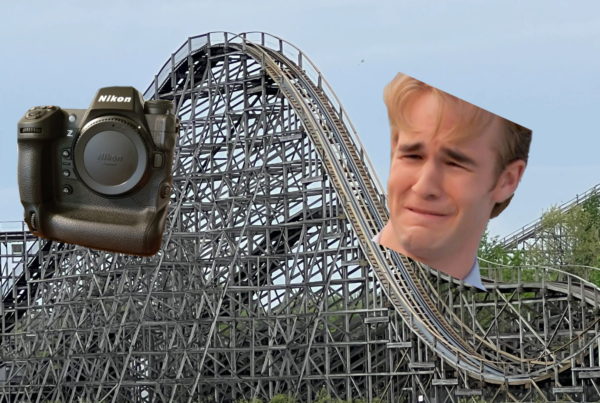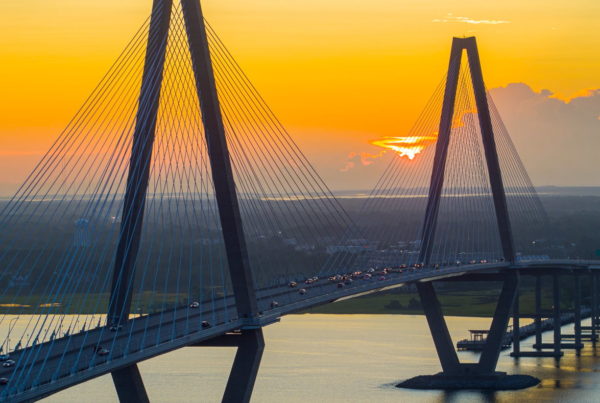Cameras Are Better for Learning Photography for This Reason
The physical interface of a modern camera body is the most important advantage over a phone when learning photography. Camera bodies are constructed to anatomically accommodate for human hands to assist in the imaging process. They are specifically manufactured so that your fingers can manipulate tactile controls rapidly while gripping the camera securely, without looking away from your subject.
This real time control over the device allows the user to completely overhaul a scene with a few turns of a dial or button press. Conversely a cellphone’s anatomical design is primarily focused on communication, content consumption and portability. To compensate for the lack of interface and hardware, cellphones rely heavily on computational and AI processing to achieve the final image.
If learning photography is a priority than purchasing an interchangeable lens camera will help that process move in a more organic way. Although it’s definitely possible to learn on a cellphone, the lack of physical interface combined with smart-assisted software restricts the user from any artistic control or exploration. A phone camera is designed to analyzes a scene milliseconds before a photo is taken and then process the photo using computational algorithms developed by a team of corporate engineers. The tradeoff is that the software will create a decent image more often than not, despite not having any artistic input from the user.
Camera bodies provide higher quality images and more creative control through a physical interface designed for photography. A camera in a photographers hand could be analogous to an instrument in a musicians hand. The handling of both artistic tools becomes second nature to a seasoned professional and so do the results.
Capture the Light, Capture the Quality
The ability for a camera sensor to gather light greatly affects the quality of the image. Sensors have gotten more efficient at gathering light, but not that much. The most practical way to get more light is still to simply make them bigger. This is the reason why the new James Webb Space Telescope has a 25 meter surface area for photographing distant stars. That’s over 6 times larger than the previous Hubble Telescope which was developed over 30 years ago! Light is incredibly important in image processing and although there have been major technological advances in computational photography there is still no substitute for physical sensor size.
When comparing the sensor size of a cellphone to a mid sized DSLR camera the difference is exponential. It’s actually remarkable that cellphone cameras can achieve the image quality that they do with such small sensor sizes. The blue rectangle (image below) represents the typical size of a full frame DSLR or mirrorless camera sensor while the bottom row shows the common cellphone sensor sizes.
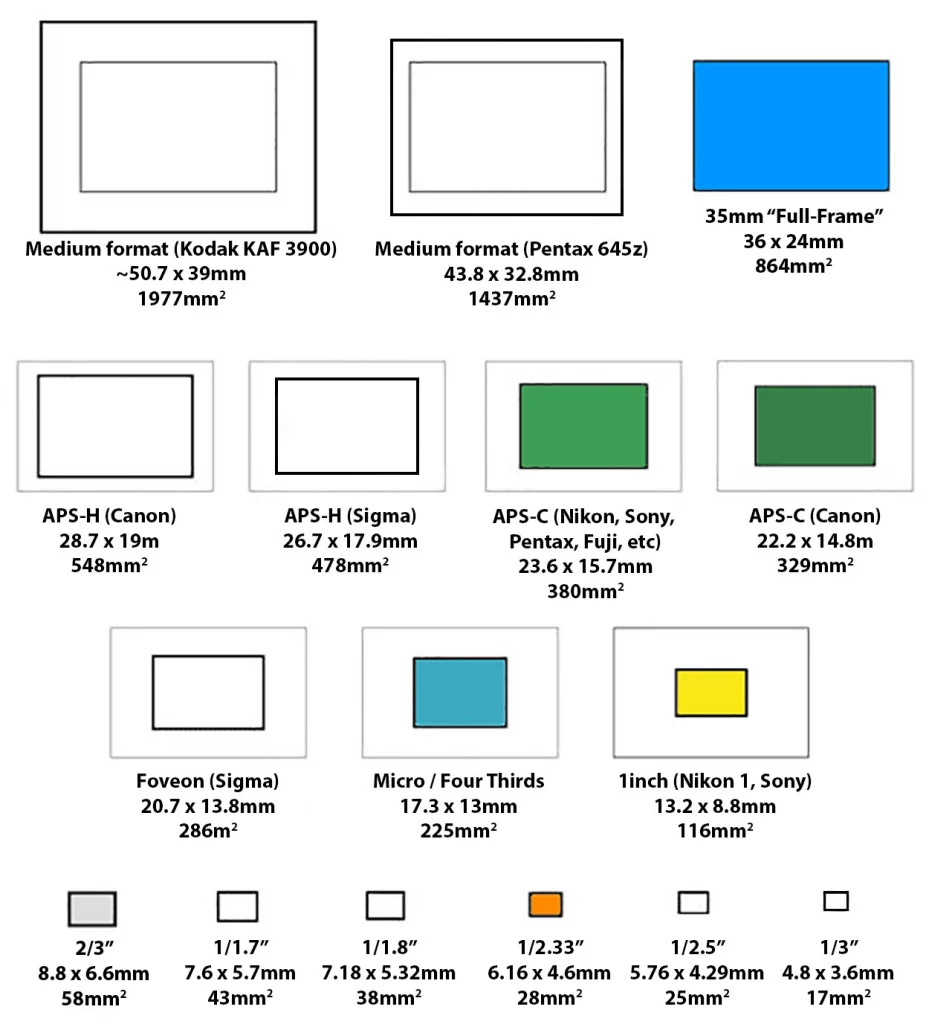
Image from ephotozine.com
A standard full frame camera sensor (blue rectangle) is 31 times larger than a mid-tier cellphone sensor (orange rectangle) and 51 times larger than the smaller sensors in older phones. Because there’s so little surface area to gather light it’s no surprise that low light photography is a cellphone’s Achilles’ heel. Even smaller point-and-shoot and micro four thirds cameras (2nd row from bottom) have a pronounced advantage over cellphones in this area. Image quality starts to suffer in the form of grain, blur and artifacts when there’s isn’t enough light for cellphone software to work with. And sometimes the results are down right cringey especially when compared with anything higher tier.
I See You Baby Shaking that Glass
One of the most undeniable advantages of owning a camera are the amount of lens choices. Specialty lenses provide the freedom to expand one’s skillset to more nuanced photography. Whether it be a macrophotography lens to photograph tiny insects in the backyard or a super telephoto lens to capture the surface of the moon, new glass opens up new opportunities. The most coveted lenses can cost significantly more than the camera bodies that they are attached to. Those lenses tend to be the staple of a photographer’s gear bag. An old photography phrase, “marry the lens, date the camera,” summarizes the sentiment perfectly.
Cellphones don’t have interchangeable glass available. The more expensive phones do come with up to 3 separate lens and camera combinations, but they are still significantly hampered by their sensor size and restrictive interface. And more importantly there’s zero chance of having the opportunity to upgrade those lenses. Once you invest in a camera body, you are investing in an ever-growing ecosystem of native and third party lenses that are constantly being developed. Prime and specialty glass can give a creator the unique look that’s inspiring while also providing superior image quality.
Downsides of Buying a Camera for Learning Photography
Time: It takes time to learn the basics of photography, photo editing and time to learn your camera system.
Cost: The cost of camera equipment and related peripherals can become a blackhole.
Social Media Sharing: Getting images from the camera to social can be cumbersome.
Learning photo editing: You will get the most out of your camera system if you learn to edit your images.
Camera Recommendations by Use Case
These recommendations only include cameras for photography (not video) and only from the top three largest camera brands; Canon, Sony and Nikon. There are other brands on the market, but these companies have a wide range of products, long track records and robust selections of new and used lenses already available. Each camera class includes a visual table with cameras arranged by price in descending order. Just because a camera is in a certain group doesn’t mean it isn’t acceptable for other types of photography.
Please understand that there are many other accessories, lenses and equipment that may be needed besides the camera to achieve the style of photography that you want. These are just basic recommendations to point a shopper in the right direction. Be sure to shop around for the camera that is right for you.
Cameras for Beginners Learning Photography
Photo scenarios: Casual, travel, family, walkaround, non-professional
Type of action: Stationary or moving subjects at slow-medium speed
Budget: On a budget (~$1,000)
For those that are just starting out or don’t have a large initial budget, this group of cameras focuses on casual, slower paced action with a clear subject such as family, pet, newborn, street, and travel photography. These would not be considered professional camera bodies because they lack advanced features that are prerequisites for most professionals. However, this is not to say they aren’t capable of producing professional results. These cameras have smaller, lower resolution sensors and slower frame rates but are lightweight, easy to use and have a wide array of affordable lenses available.
| Nikon | Canon | Sony |
| D3500 | Rebel SL3 | ZV-E10 |
| D5600 | Rebel T8i | a6100 |
| Z50 | M50 | a6400 |
| Z5 | RP | a6500 |
Cameras for Sports, Wildlife and Action Photography
Photo scenarios: Action adventure sports, birds in flight, nature and wildlife, team sports, pets or children at play
Type of action: Outdoor high speed action
Budget: Moderate
When things speed up and the action gets going it can be difficult or even impossible to get a usable shot with a cellphone especially if the action is taking place far away. Cameras designed for action photography have small to medium sized sensors designed for fast frame rates. They also utilize highly accurate autofocus systems to keep the subject sharp through the action. This group of cameras thrive at shooting sports, action and wildlife especially outdoors. The less expensive, crop sensor cameras in this group struggle in low light and indoor photography due to their smaller sensor sizes.
| Nikon | Canon | Sony |
| D7500 | 7D MII | a6500 |
| D500 | 90D | a7R II |
| Z6 II | 6D MII | a9 |
| Z9 | R6 | a9 II |
Cameras for Landscape Photography
Photo scenarios: Sunrise and sunset landscapes, long exposure, night, real estate, detailed high dynamic range scenes
Type of action: Stationary, slow paced action
Budget: Moderate-Expensive
Professional landscape photography involves the meticulous execution of exposure, framing, time of day and location to produce a desirable composition. High megapixel counts, large sensors and slow framerates are common characteristics for these type of cameras. Cameras for landscape photography can capture high dynamic range scenes like sunrise/sunsets and produce superior detail in wider compositions. The downside of these cameras is they are more expensive, have larger file sizes and they tend to be bigger and heavier.
| Nikon | Canon | Sony |
| D810 | EOS RP | a7 R |
| D850 | 5DS R | a7 R II |
| Z7 | EOS R | a7R IV |
| Z7 II | R5 | A1 |
Cameras for Portraits, Events and Lifestyle
Photo scenarios: People focused photography, weddings, events, fashion, lifestyle, press and photojournalism
Type of action: Slow-medium paced action, non-sports
Budget: Moderate-Expensive
For professionals who specialize in portrait photography or those that need to capture people in a variety of environments, this group of cameras feature versatile, full frame sensors, accurate auto focus systems and redundant memory card slots. The newer, higher end models feature advanced image recognition with eye detection for people, pets and other animals. This means the user is free to focus on composition while the camera automatically keeps a subject in focus. This is unbelievably useful in video as well. These cameras have medium-high framerates, medium-high megapixel counts and tend to be average in size and weight.
| Nikon | Canon | Sony |
| Z6 | 6D II | A7 IV |
| Z6 II | 90 D | A7R III |
| Z7II | 5D IV | A99 II |
| Z9 | R5 | a7R IV |
Cameras for Night and Astrophotography
Photo scenarios: Low light and night scenes, starscapes, nightscapes, long exposure landscapes, moon photography
Type of action: Stationary
Budget: Moderate-Expensive
Cameras for night and astrophotography specialize in gathering light while keeping image noise to a minimum in low light and night scenes. This group is characterized with having full frame sensors with a medium amount of pixels each of which are larger than their higher pixel counterparts. Larger pixels improve performance by allowing more light in which produces more accurate measurements. The downside is that although these images are cleaner, they are lower resolution and harder to recompose in post production.
| Nikon | Canon | Sony |
| Z6 | 90D | A7 II |
| D780 | RA | A7 III |
| 810a/D850 | 5D IV | a7R III |
| Z6 II | R6 | a7R IV |

